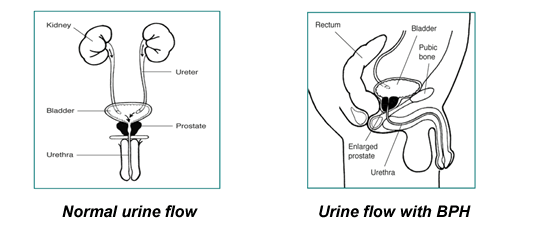General Information
It is common for the prostate gland to become enlarged as a man ages. Doctors call this condition benign prostatic hyperplasia (BPH), or benign prostatic hypertrophy.
As a man matures, the prostate goes through two main periods of growth. The first occurs early in puberty, when the prostate doubles in size. At around age 25, the gland begins to grow again. This second growth phase often results, years later, in BPH.
Though the prostate continues to grow during most of a man’s life, the enlargement doesn’t usually cause problems until late in life. BPH rarely causes symptoms before age 40, but more than half of men in their sixties and as many as 90 percent in their seventies and eighties have some symptoms of BPH.
As the prostate enlarges, the layer of tissue surrounding it stops it from expanding, causing the gland to press against the urethra like a clamp on a garden hose. The bladder wall becomes thicker and irritable. The bladder begins to contract even when it contains small amounts of urine, causing more frequent urination. Eventually, the bladder weakens and loses the ability to empty itself, so some of the urine remains in the bladder. The narrowing of the urethra and partial emptying of the bladder cause many of the problems associated with BPH.
Many people feel uncomfortable talking about the prostate, since the gland plays a role in both sex and urination. Still, prostate enlargement is as common a part of aging as gray hair. As life expectancy rises, so does the occurrence of BPH. In the United States in 2000, there were 4.5 million visits to physicians for BPH.
Symptoms
Many symptoms of BPH stem from obstruction of the urethra and gradual loss of bladder function, which results in incomplete emptying of the bladder. The symptoms of BPH vary, but the most common ones involve changes or problems with urination, such as
- a hesitant, interrupted, weak stream
- urgency and leaking or dribbling
- more frequent urination, especially at night
How We Test For BPH
Prostate-Specific Antigen (PSA) Blood Test
To rule out cancer as a cause of urinary symptoms, your doctor may recommend a PSA blood test. PSA, a protein produced by prostate cells, is frequently present at elevated levels in the blood of men who have prostate cancer. The U.S. Food and Drug Administration (FDA) has approved a PSA test for use in conjunction with a digital rectal examination to help detect prostate cancer in men who are age 50 or older and for monitoring men with prostate cancer after treatment. However, much remains unknown about the interpretation of PSA levels, the test’s ability to discriminate cancer from benign prostate conditions, and the best course of action following a finding of elevated PSA.
Rectal Ultrasound and Prostate Biopsy
If there is a suspicion of prostate cancer, your doctor may recommend a test with rectal ultrasound. In this procedure, a probe inserted in the rectum directs sound waves at the prostate. The echo patterns of the sound waves form an image of the prostate gland on a display screen. To determine whether an abnormal-looking area is indeed a tumor, the doctor can use the probe and the ultrasound images to guide a biopsy needle to the suspected tumor. The needle collects a few pieces of prostate tissue for examination with a microscope.
Urine Flow Study
Your doctor may ask you to urinate into a special device that measures how quickly the urine is flowing. A reduced flow often suggests BPH.
Cystoscopy
In this examination, the doctor inserts a small tube through the opening of the urethra in the penis. This procedure is done after a solution numbs the inside of the penis so all sensation is lost. The tube, called a cystoscope, contains a lens and a light system that help the doctor see the inside of the urethra and the bladder. This test allows the doctor to determine the size of the gland and identify the location and degree of the obstruction.

